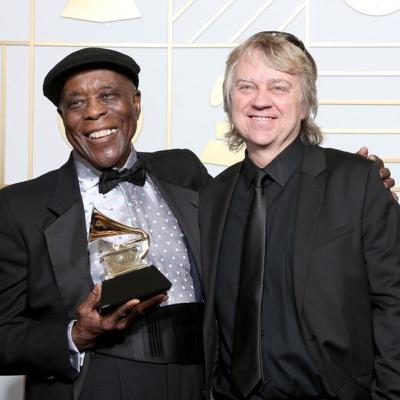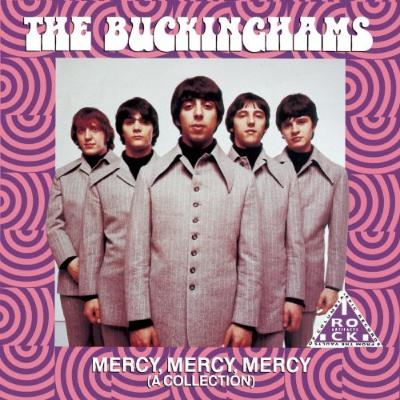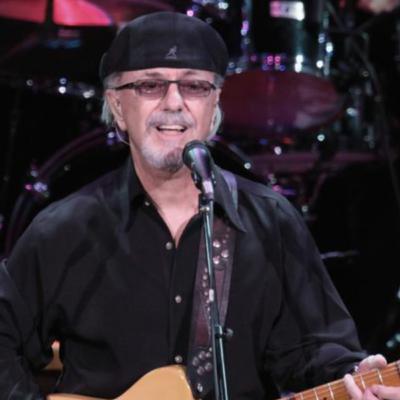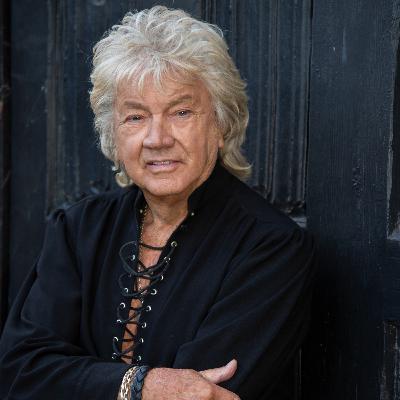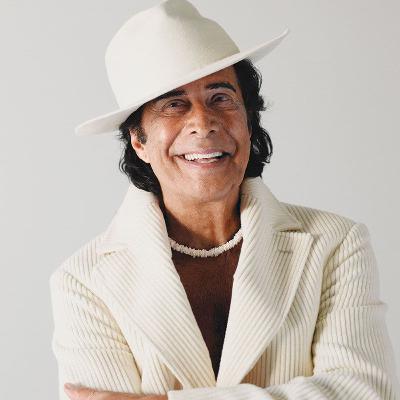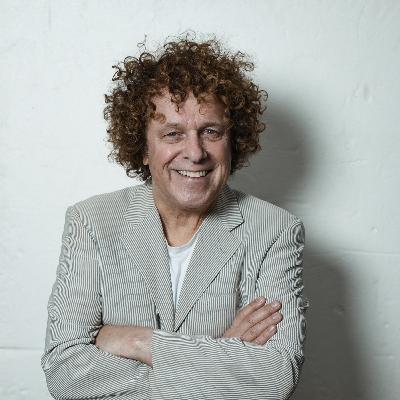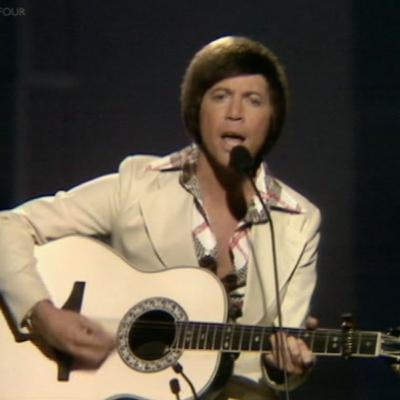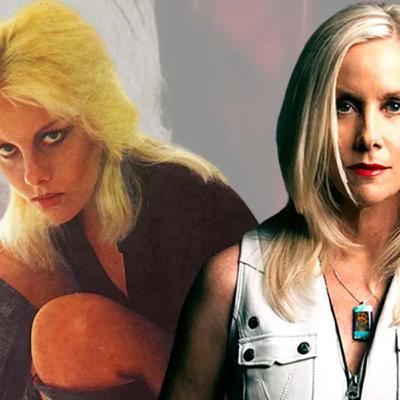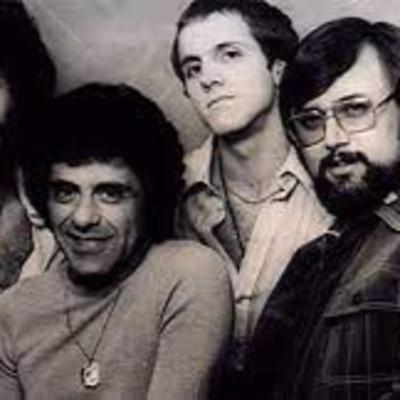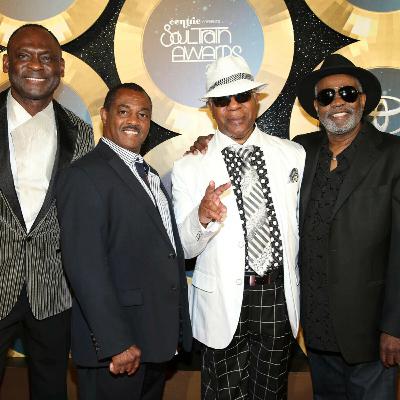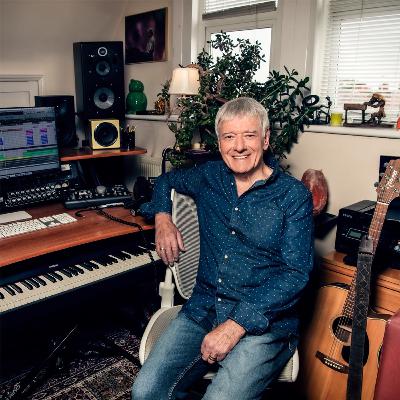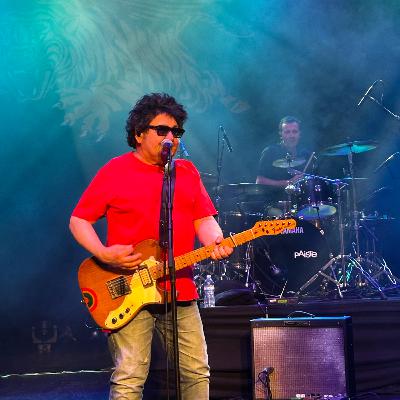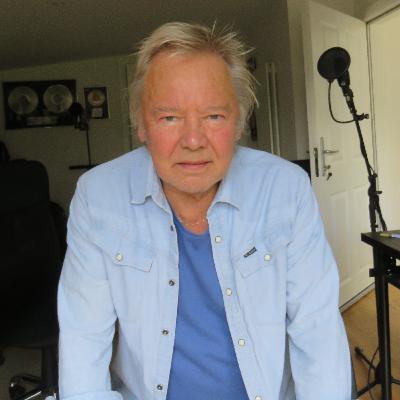Discover '60s '70s '80s - Warm, Candid, Classic, Rock Interviews with Music Legends - A BREATH OF FRESH AIR
'60s '70s '80s - Warm, Candid, Classic, Rock Interviews with Music Legends - A BREATH OF FRESH AIR

'60s '70s '80s - Warm, Candid, Classic, Rock Interviews with Music Legends - A BREATH OF FRESH AIR
Author: Sandy Kaye
Subscribed: 78Played: 1,756Subscribe
Share
© Sandy Kaye
Description
Iconic artists? Music Legends? Sandy Kaye interviews them all on A Breath of Fresh Air - a multi award-winning podcast featuring in-depth interviews with the artists you love. Through compelling conversations, we gain a rare, behind-the-scenes and intimate look at the personal stories and inspirations that fueled the music that shaped entire generations.
Explore the lives, struggles, and creative journeys of these legends and relive the timeless hits that defined the soundtrack of our youth.
It's all about Their Lives. Their Stories. Their Music
https://www.abreathoffreshair.com.au
Explore the lives, struggles, and creative journeys of these legends and relive the timeless hits that defined the soundtrack of our youth.
It's all about Their Lives. Their Stories. Their Music
https://www.abreathoffreshair.com.au
207 Episodes
Reverse
Tom Hambridge is a Grammy Award-winning drummer, songwriter, and producer whose fingerprints are all over modern blues and rock music. Known for his powerhouse drumming, soulful songwriting, and Grammy-winning production work, Hambridge has built an extraordinary career that bridges the worlds of stage and studio — working alongside some of the biggest legends in American music.Born and raised in Buffalo, New York, Tom began playing drums at the age of five, showing an instinctive sense of rhythm that would shape his life. He studied at the prestigious Berklee College of Music in Boston, where he honed his craft not only as a drummer but also as a singer, songwriter, and producer. Before becoming one of Nashville’s most in-demand producers, Hambridge led his own band, Tom Hambridge & The Rattlesnakes, building a devoted following for his high-energy live shows and original songs that blended blues, rock, and Americana influences.Hambridge’s reputation as a go-to songwriter and producer skyrocketed when he began collaborating with blues icon Buddy Guy. Their creative partnership produced a string of critically acclaimed albums, including Skin Deep, Living Proof, and The Blues Don’t Lie. These records not only revitalized Guy’s career but also earned multiple Grammy Awards and Blues Music Awards, cementing Hambridge’s place as one of the leading producers in contemporary blues.Beyond Buddy Guy, Tom has written and produced for an impressive roster of legendary artists, including Susan Tedeschi, George Thorogood, Joe Bonamassa, James Cotton, Kenny Wayne Shepherd, ZZ Top’s Billy Gibbons, and Johnny Winter. His songs have been covered and recorded by icons across genres, from rock to country, demonstrating his remarkable versatility and storytelling gift.While his songwriting and production credits are extensive, Tom Hambridge’s drumming credentials are equally impressive. He has toured and recorded with artists such as Delbert McClinton, Boston, and Chuck Berry, always delivering his signature mix of groove, drive, and precision. Whether behind the kit in the studio or on stage at major festivals, Hambridge’s playing exudes both heart and technical mastery.As a solo artist, Tom has released several acclaimed albums that showcase his gritty vocals and songwriting depth. Today, Tom Hambridge stands as one of the most respected figures in modern blues and roots music. With multiple Grammys, dozens of producer credits, and a reputation for elevating every artist he works with, Hambridge’s influence reaches far beyond the studio. Whether producing chart-topping albums, writing soulful hits, or performing his own electrifying shows, he continues to shape the sound of contemporary American music — one song, one beat, and one record at a time.What’s Inside This EpisodeTom Hambridge’s early years, musical upbringing, and path to BerkleeHow he built his career before writing for major artistsThe rise of Tom Hambridge & The Rattlesnakes and his early solo workHis game-changing songwriting and production partnership with Buddy GuyThe major artists he has written for and produced, from Joe Bonamassa to Susan TedeschiThe legendary musicians he has drummed for on stage and in the studioA look at his acclaimed solo albums including Boom!, The NOLA Sessions, and Blues Don’t CareHow Hambridge helped shape the modern blues soundHis ongoing influence as a drummer, songwriter, and Grammy-winning producerFor further information on Tom head to his website: http://hambridgetunes.com/With comments or suggestions head to my website: https:www.abreathoffreshair.com.au
In this episode, we dive into the story of Dennis Tufano, the unmistakable voice that brought The Buckinghams to the top of the charts during one of the most exciting eras in American pop and rock music.Dennis Tufano’s journey began in Chicago, a city whose vibrant music scene gave rise to countless legends. Long before he was singing “Kind of a Drag” on national television, Dennis was fronting local Chicago bands like The Pulsations, performing in small clubs and perfecting the soulful vocal style that would soon make him famous. When The Pulsations won a TV talent contest and rebranded as The Buckinghams, everything changed—almost overnight.The Buckinghams burst onto the charts in 1967 with “Kind of a Drag,” a song that captured the hearts of fans and climbed straight to number one on the Billboard Hot 100. With Dennis Tufano’s velvety voice leading the way, the band followed up with a string of unforgettable hits: “Don’t You Care,” “Mercy, Mercy, Mercy,” “Susan,” and “Hey Baby (They’re Playing Our Song).”At the height of their success, The Buckinghams were one of the most played American groups on radio, performing on The Ed Sullivan Show, American Bandstand, and countless other programs that defined 1960s pop culture. Their fusion of brass-driven rock and soul-infused pop set them apart from both their British contemporaries and the emerging psychedelic rock sound of the time.But Tufano’s story didn’t end when the hits stopped coming. After The Buckinghams disbanded, Dennis formed the duo Tufano & Giammarese with his former bandmate Carl Giammarese, recording several critically acclaimed albums in the 1970s. The duo showcased a more intimate, singer-songwriter vibe that highlighted Tufano’s range and songwriting depth.From there, Dennis moved into solo work, writing and recording for film and television—most notably contributing the theme song to Grease 2. He also worked as a voice actor and composer, keeping his creative spirit alive in new ways.Today, Dennis Tufano remains a beloved performer on the classic rock and oldies circuit, delighting fans with heartfelt performances that revisit The Buckinghams’ timeless hits while celebrating his own musical evolution. His live shows remind audiences why his voice was, and still is, one of the most distinctive in American pop music.In this episode, we talk about his early Chicago days, the meteoric rise of The Buckinghams, and how Dennis carved out a remarkable solo career that’s still going strong decades later.If you’re a fan of 1960s rock, Chicago music history, or the golden age of pop, this episode is a must-listen.🎧 Tune in to hear:How Dennis Tufano helped shape the sound of 1960s American pop-rock.Behind-the-scenes stories of The Buckinghams’ biggest hits.What life was like after the band’s breakup.How Dennis continues to connect with fans old and new.To reach with me with comments, feedback or suggestions for future guests, head to my website here
In this episode we explore the remarkable journey of Bernie Leadon, the multi-instrumentalist and songwriter whose artistry helped define The Eagles’ early sound. Often called the unsung hero of The Eagles, Bernie’s contributions — from intricate guitar and banjo work to his soaring harmonies — helped shape a sound that has resonated for decades.From his early exposure to bluegrass and folk music in Minneapolis to his groundbreaking work in the West Coast country-rock scene, Bernie Leadon has remained a quiet but powerful force in American music. In this episode, we follow Bernie’s path before, during, and after The Eagles, all the way to his most recent solo album, where he revisits the roots that first inspired him.Bernard Leadon III was born in Minneapolis, Minnesota, into a family that encouraged both creativity and education. While his father worked as an aeronautical engineer and his mother was a teacher, it was the sounds of bluegrass, folk, and country that truly captured young Bernie’s imagination.By his teenage years, Bernie had mastered guitar, banjo, mandolin, and dobro, instruments that would become central to his career. After moving to San Diego, he immersed himself in the local music scene, connecting with influential figures like Chris Hillman and Gram Parsons, who would later become pivotal in the country-rock movement.Before joining The Eagles, Bernie Leadon played in several key bands that helped define the emerging country-rock genre. He worked with Hearts & Flowers, Dillard & Clark, and most famously, The Flying Burrito Brothers. During this period, Bernie became known as a musician who could add texture and authenticity to any song. His instrumental versatility and collaborative spirit made him highly sought after, setting the stage for his next big move.In 1971, Bernie Leadon joined Glenn Frey, Don Henley, and Randy Meisner to form The Eagles. His influence was immediate. On the band’s debut album, Eagles (1972), Bernie’s mastery of the banjo, guitar, and mandolin was showcased on hits like Take It Easy and Peaceful Easy Feeling. His harmonies and songwriting contributions, including Train Leaves Here This Morning and Bitter Creek, helped define the band’s distinctive country-rock sound.Bernie continued to shape The Eagles’ music on Desperado (1973), On the Border (1974), and One of These Nights (1975). However, as the band gravitated toward a rock-oriented direction with the addition of Don Felder and later Joe Walsh, Bernie felt increasingly disconnected from the evolving sound. In 1975, after years of touring and creative differences, Bernie famously left the band, marking the end of an era for both him and The Eagles.Following his departure, Bernie Leadon remained highly active in the music industry. He became a respected session musician, contributing to recordings by Linda Ronstadt, Emmylou Harris, Stephen Stills, Randy Newman, and many others. In 1977, he released his first solo album, Natural Progressions, blending his bluegrass roots with rock and folk influences.Over the decades, Bernie continued to perform, collaborate, and record — he returned to The Eagles’ “History of the Eagles” tour in 2013.Today, Bernie Leadon has returned with a reflective new solo album called "Too Late to be Cool" showcasing the depth and authenticity that have characterised his entire career. In this episode, we talk about Bernie’s journey, his thoughts on music, and what it means to create art on his own terms. Bernie’s story is a testament to creativity, versatility, and staying true to one’s musical voice.Whether you’re a lifelong Eagles fan, a lover of country-rock, or someone curious about the musicians behind the music, this episode is packed with insights, stories, and reflections. Bernie Leadon may not always have sought the spotlight, but his impact on American music is undeniable.
Few artists in Australian rock can rival the mystique and creative longevity of Steve Kilbey, the visionary frontman, bassist, and chief songwriter for The Church. In this captivating and wide-ranging episode of A Breath of Fresh Air with Sandy Kaye, Steve joins Sandy for an honest, funny, and deeply revealing conversation about his extraordinary life in music — before, during, and long after The Church became global icons.Born in Welwyn Garden City, England, and raised in Canberra, Australia, Steve’s story begins long before his name became synonymous with the band that gave us Under the Milky Way. He talks about his early fascination with sound — from his parents’ record collection to the spark that led him to pick up a guitar. Before fame, there were years of small gigs, knock-backs, and sheer determination to make his art heard.In 1980, that persistence paid off. Steve co-founded The Church, alongside guitarist Peter Koppes, drummer Nick Ward, and later Marty Willson-Piper. Their unique blend of shimmering guitars, surreal lyrics, and atmospheric soundscapes quickly set them apart. Their debut single, The Unguarded Moment, catapulted them to prominence, and soon The Church became one of Australia’s most distinctive exports — a band equally loved for its mystery as for its music.But it was 1988’s Starfish that turned The Church into international stars. The haunting single Under the Milky Way became a global anthem, securing their place in rock history. In this episode, Steve tells the story behind that song — the serendipity of its creation, his initial doubts, and how it continues to define the band’s legacy decades later.Steve also shares candid insights into the creative tensions and triumphs within The Church — what it’s like to lead a band for more than forty years, to evolve through changing line-ups, and to stay inspired through it all. He discusses how albums like Priest=Aura and Hologram of Baal marked turning points in their sound, and how the band’s most recent work, including The Hypnogogue, proves they’re still pushing boundaries today.Beyond the band, Steve’s story is one of relentless creativity. He’s released more than 20 solo albums, collaborated with artists like Grant McLennan and Martin Kennedy, and built a reputation as a painter, poet, and author. His life is art in motion — a never-ending exploration of sound, colour, and language.Throughout the conversation, Sandy and Steve explore everything from fame and spirituality to songwriting, success, and the wisdom that comes with time. He reflects on how his creative process has evolved, the lessons he’s learned from the highs and lows, and what keeps him making music with such passion after all these years.As always, Steve’s dry humour, self-awareness, and poetic way of thinking shine through. This episode is more than an interview — it’s an invitation into the inner world of a true artist, still searching, still experimenting, and still mesmerising audiences worldwide.If you’ve ever been moved by Under the Milky Way, fascinated by the evolution of Australian rock, or curious about what drives a lifelong creative soul, this is one you won’t want to miss.🎧 Listen now for a journey through sound, story, and the mind of Steve Kilbey — the heart and soul of The Church.Do you have an artitst you'd like to hear from? Get in touch with me through the website here
Few names shine as brightly in the story of American rock and roll as Dion DiMucci. Known to fans worldwide simply as Dion, this Bronx-born legend isn’t just another voice from the golden age of doo-wop—he’s one of the few artists who managed to bridge the gap between early rock, blues, folk, and contemporary roots music. With a career spanning more than six decades, Dion has gone from street-corner harmony to global acclaim, influencing generations along the way.Born in 1939, in the Bronx, Dion grew up surrounded by rhythm, radio, and raw emotion. Those bustling city streets were alive with music—doo-wop groups harmonizing on stoops, gospel voices in local churches, and the pulse of rhythm and blues drifting from open windows. That mix became Dion’s musical DNA.As a teenager, Dion formed Dion and the Belmonts, named after a Bronx street. Their blend of silky harmonies and streetwise swagger set them apart from other vocal groups of the era. Songs like “I Wonder Why,” “A Teenager in Love,” and “Where or When” became instant classics—defining the sound of late 1950s rock and roll and turning Dion into a household name.Breaking Out Solo with “Runaround Sue” and “The Wanderer”When Dion went solo in 1960, he didn’t miss a beat. His breakout single “Runaround Sue” soared to number one, followed closely by “The Wanderer.” With its unforgettable swagger and sing-along chorus, “The Wanderer” captured Dion’s street-smart confidence and has since become one of the most covered songs in rock history.These weren’t just catchy pop tunes—they were the soundtrack of youth in postwar America. Dion’s voice carried a blend of toughness and tenderness that spoke to millions. He was the rebel with heart, the Bronx kid who brought soul and honesty to early rock ’n’ roll.Like many stars of his generation, Dion faced personal struggles as fame took its toll. The pressures of the road and the darker side of the music industry led to battles with addiction. But in classic Dion fashion, he turned those hardships into growth. After finding sobriety and rediscovering his faith in the late 1960s, Dion re-emerged with a deeper, more introspective sound.His 1968 hit “Abraham, Martin and John” marked a turning point. A moving tribute to Lincoln, Martin Luther King Jr., and the Kennedy brothers, the song revealed a new side of Dion—soulful, reflective, and socially aware. It became one of the defining tracks of its era, reminding fans that Dion wasn’t just a rock singer—he was a storyteller with something meaningful to say.Rediscovering the BluesThrough the '70s and beyond, Dion continued to evolve, diving deep into his earliest musical love—the blues. Albums like “Bronx in Blue” (2006) and “Son of Skip James” (2007) showed a raw, authentic artist at work. His 2020 release “Blues with Friends” brought together an all-star lineup including Bruce Springsteen, Billy Gibbons, Paul Simon, and Jeff Beck. The record earned rave reviews, proving that Dion’s voice and songwriting remain as powerful and relevant as ever.Dion’s influence stretches across generations. From Bob Dylan and Lou Reed to Bruce Springsteen, countless artists have cited him as a major inspiration. His ability to blend doo-wop sweetness, rock grit, and blues soul has kept his music timeless—and his storytelling authentic.In '89, Dion was inducted into the Rock and Roll Hall of Fame, cementing his status as one of the genre’s founding fathers. But more than awards or accolades, Dion’s true legacy lies in his unwavering authenticity. He’s never chased trends; he’s chased truth.In an age where musical fads come and go, Dion’s story reminds us what staying power really looks like. His career is a masterclass in reinvention. Whether he’s singing about heartbreak, hope, or redemption, Dion remains one of rock’s most honest voices.Six decades on, the Bronx-born rock legend is still doing what he’s always done best—telling stories that sound like they were written just for you.
From Birmingham to the Rock Hall: the life, legacy, and love of Moody Blues bassist John Lodge.John Lodge (July 20, 1943 – October 10, 2025) was far more than the bass player for The Moody Blues — he was the gentle soul and musical anchor behind one of rock’s most beloved bands. With his distinctive melodic bass, soaring harmonies, and thoughtful songwriting, Lodge helped turn The Moody Blues from a struggling R&B group into pioneers of symphonic and progressive rock.Born in Birmingham, John grew up surrounded by the post-war explosion of British music. He joined The Moody Blues in 1966, along with guitarist Justin Hayward, just as the band was ready to reinvent itself. Together they reshaped the group’s direction, moving away from covers and pop singles toward the lush, conceptual sound that would define the late 1960s. Their first major success, Days of Future Passed (1967), blended rock with classical orchestration and produced the timeless hit “Nights in White Satin.” Lodge’s basslines and harmonies underpinned that transformation — a sound that felt cinematic, emotional, and deeply human.Over the next five decades, John Lodge’s touch could be felt across The Moody Blues’ greatest works. He wrote and sang enduring tracks like “Ride My See-Saw,” “Isn’t Life Strange,” and “I’m Just a Singer (In a Rock and Roll Band),” each one showcasing his knack for combining big ideas with irresistible hooks. While the band explored spirituality, time, and love through albums like In Search of the Lost Chord and A Question of Balance, Lodge kept their music grounded with rhythmic depth and melodic grace.As The Moody Blues evolved through the 1970s and 1980s, Lodge remained the band’s creative backbone. His songwriting and stage presence were steady and sincere, and his partnership with Hayward became one of rock’s most enduring collaborations. The group’s music inspired generations, selling over 70 million albums and securing their place as one of the most influential acts in British rock history. In 2018, their induction into the Rock & Roll Hall of Fame marked the culmination of that extraordinary journey — a moment Lodge often described as “the completion of a dream we started as kids.”Even after The Moody Blues stopped touring in 2018, John Lodge’s creative fire never dimmed. He continued recording and performing with his “10,000 Light Years Band,” revisiting classic Moody Blues songs while writing new ones that carried his message of faith and hope. His solo projects included B Yond (2019), The Royal Affair and After (2021), and Days of Future Passed – My Sojourn (2023), a heartfelt reinterpretation of the Moody Blues’ 1967 masterpiece. His final release, Love Conquers All (2025), and the moving single “Whispering Angels,” co-written with his son-in-law Jon Davison of Yes, captured Lodge’s optimism and belief in love’s enduring power.Offstage, John Lodge lived a grounded life. Married to his wife Kirsten since 1968, he was a devoted husband and father to their children, Emily and Kristian. His song “Emily’s Song” remains one of his most tender creations, written as a gift for his daughter and cherished by fans for its emotional honesty. Lodge often credited his Christian faith with keeping him centered through the highs and lows of fame, and he spoke often about gratitude — for music, family, and the fans who shared the journey with him.John Lodge passed away on October 10, 2025, at age 82, surrounded by family and the sounds of The Everly Brothers and Buddy Holly — the artists who first inspired him. His passing marked the end of an era, but his spirit lives on in the music that continues to inspire listeners around the world.From Birmingham stages to the Rock & Roll Hall of Fame, John Lodge’s story is one of faith, friendship, and timeless creativity. He reminded us that true artistry isn’t about chasing fame — it’s about touching hearts. And through every note he played, he did exactly that.
Get ready for an unforgettable conversation with Shelly Clark, the powerhouse singer, dancer, and actress who helped shape the sound of 1970s R&B as a founding member of the chart-topping girl group Honey Cone.Born in Brooklyn and performing professionally by the age of six, Shelly Clark’s career began on Broadway before she went on to tour with legends like Cab Calloway and work as an Ikette in the Ike & Tina Turner Revue. But her real breakthrough came in 1968, when she co-founded Honey Cone with Edna Wright and Carolyn Willis.With Holland-Dozier-Holland behind them at the Hot Wax/Invictus label, Honey Cone shot to stardom. Their smash hit “Want Ads” hit No.1 on both the Billboard Pop and R&B charts in 1971 and sold over a million copies. Follow-up hits like “Stick-Up,” “One Monkey Don’t Stop No Show,” and “The Day I Found Myself” cemented their place in music history. Honey Cone weren’t just about catchy hooks — their lyrics spoke to female empowerment and independence, making them trailblazers in the girl-group era.After the group disbanded, Shelly turned down an offer to join The Supremes and instead found a new path in television, solo work, and later in her personal life. In 1980, she married Verdine White, legendary bassist of Earth, Wind & Fire. Their marriage has lasted more than four decades, built on music, love, and mutual respect. Today, Shelly continues to collaborate with Verdine, including producing his 2024 solo project “Superman.”In recent years, Shelly has also revived Honey Cone with a new lineup, bringing timeless classics to fresh audiences. In 2024, the group released their first single in 50 years — a stunning cover of the Eurythmics’ “Here Comes the Rain Again.”This episode dives deep into Shelly Clark’s incredible journey — from Broadway beginnings to No.1 hits, from Honey Cone fame to life with Verdine White, and her ongoing legacy as a singer, producer, and keeper of soul and R&B history.If you love 70s soul, R&B girl groups, Earth, Wind & Fire, or music history, this is one story you won’t want to miss.If you have any suggestions for guests for this show, or any commnents or feedback please reach out to me via the website https://www.abreathoffreshair.com.au#shellyclark #ikette #honeyCone #earthwindandfire
When you think of catchy pop anthems from the late ’60s and ’70s, chances are Andy Kim’s fingerprints are all over them. The Canadian singer-songwriter carved out a space in music history with a string of hits that defined an era, yet his journey stretches far beyond his chart-toppers. From his humble beginnings in Montreal to penning global hits, stepping away from fame, and eventually enjoying a triumphant comeback, Andy Kim’s story is as fascinating as his music.Born Andrew Youakim, the son of Lebanese immigrants, Andy grew up in a large family surrounded by music . He was drawn to the excitement and energy of rock and roll, idolizing Elvis and Buddy Holly, while dreaming of making it big himself. By his teens, he was already writing songs, learning the ropes of show business, and imagining a future far beyond the streets of Montreal.At just 16, Kim headed to New York City with little more than ambition and determination. He knocked on doors in Manhattan’s famous Brill Building, the mecca of songwriting in the '60s, where legends like Carole King, Neil Diamond, and Jeff Barry were crafting timeless hits. His persistence paid off—he eventually landed a meeting with producer Jeff Barry, who became his mentor and collaborator.In '68, Andy Kim released his first single which cracked the Top 20 in the U.S. This early success was just the beginning. The following year, he co-wrote Sugar, Sugar for the fictional band The Archies. The bubblegum pop anthem became a worldwide smash, selling over six million copies. Even though Andy wasn’t the face of the Archies, his contribution to one of the biggest hits of the decade cemented his reputation as a first-class songwriter.Andy followed up with his own string of solo hits. His knack for crafting feel-good melodies kept him on the charts and in demand throughout the early ’70s.The defining moment of Andy Kim’s career came in '74 with Rock Me Gently. Written, produced, and recorded entirely on his own terms, Kim initially struggled to get labels interested. Refusing to give up, he pressed the record himself, and the gamble paid off. The song soared to No. 1 and became an international hit. At the height of his fame, Andy Kim was a household name. But the music industry can be fickle. After the success of Rock Me Gently, the hits became harder to come by. By the late ’70s and ’80s, Andy chose to step back from the spotlight. He adopted the pseudonym Baron Longfellow and released music under that name, but the commercial magic of his earlier work proved elusive.Still, he never stopped writing and recording. Though he wasn’t topping charts anymore, he was quietly influencing younger artists and remaining connected to the craft he loved.In the '90s and 2000s, Andy's legacy started to be celebrated more widely. Younger musicians, especially in Canada, cited him as a pioneer. In 2004, he made a triumphant return with I Forgot to Mention, written with Barenaked Ladies’ Ed Robertson. That collaboration rekindled his profile.In 2015, he released the album It’s Decided, produced with Kevin Drew of Broken Social Scene. Andy Kim’s contributions haven’t gone unnoticed. He’s been inducted into Canada’s Music Hall of Fame, received the Order of Canada, and continues to be recognized as a national treasure. His enduring influence lies not just in the timeless appeal of Rock Me Gently and Sugar, Sugar, but also in his perseverance, humility, and generosity.Even today, Andy is active in the music world, performing, mentoring, and celebrating the power of song. His story is a testament to resilience—a reminder that the peaks and valleys of fame can’t overshadow genuine talent and passion.Andy joins us today to share his story. I really hope you enjoy it.
This week, I had the pleasure of sitting down with Graeme Clark, founding bassist of Wet Wet Wet, and the band’s newest frontman, Kevin Simm. Together, they take us on a journey through the band’s humble beginnings, meteoric rise to fame, their unforgettable hit Love Is All Around, and how they’ve kept the magic alive four decades later.Wet Wet Wet formed back in 1982 in Glasgow, Scotland. For Graeme and his school friends, music wasn’t just a hobby—it was an escape from the bleak job prospects that faced so many young people at the time. With shipyards closed and unemployment sky-high, the boys turned their energy towards music.None of them were formally trained. What they lacked in technical skills, they made up for in passion and persistence. Graeme picked up the bass because of his love for reggae, Tommy was already playing drums, Neil joined in on keyboards, and Marty Pellow took the mic as lead vocalist. It wasn’t long before they realised they had something special.In 87, Wet Wet Wet released their debut single. To their amazement, the track shot up the charts. Following their early success, the band toured relentlessly, even opening for Elton John in America. Although they never quite cracked the U.S., their popularity soared across the UK, Europe, and Australia.A major turning point came in 88 when their version of With a Little Help from My Friends went to number one in the UK. The song that defined Wet Wet Wet’s career was their 94 cover of The Troggs’ classic Love Is All Around. Chosen for the soundtrack of Four Weddings and a Funeral, the band thought it might make a decent B-side.But once it was released, it exploded worldwide. Spending 15 consecutive weeks at number one in the UK, the single became the country’s best-selling love ballad of the decade. The success was so overwhelming that the band eventually pulled the record from sale—otherwise, it might have stayed at the top indefinitely!Like many hugely successful bands, Wet Wet Wet eventually hit a wall. After years of constant touring and chart domination, tensions and different ambitions led to a split. Graeme reflects on this period as both exhilarating and challenging. Eventually, the band regrouped in the 2000s, realising that their chemistry was too strong to leave behind.In 2018, following Marty Pellow’s departure, Wet Wet Wet welcomed Kevin Simm as their new lead singer. Kevin had already won The Voice UK in 2016.Kevin brought fresh energy to the band, not just as a performer but also as a songwriter. Together, he and Graeme started writing new material, determined to keep Wet Wet Wet moving forward.Their 2021 album, The Journey, proved that the band could still create relevant, heartfelt music. Nearly 40 years after their formation, Wet Wet Wet continue to perform and record, delighting audiences with classics like Sweet Little Mystery, Goodnight Girl, and of course, Love Is All Around. At the same time, they’re carving out a new chapter with Kevin at the helm.For Graeme, success today isn’t about topping charts or selling millions of records—it’s about contentment, creativity, and connection. What makes Wet Wet Wet so timeless? Maybe it’s their working-class roots, which make their story relatable. Maybe it’s their knack for writing songs that speak to life’s ups and downs. Or maybe it’s the fact that their music has been woven into the soundtrack of so many of our lives.From Glasgow’s back rooms to global arenas, from B-sides to record-breaking hits, Wet Wet Wet have weathered every storm and come out stronger. With Kevin Simm breathing new life into the group, their journey is far from over.#wetwetwet #80sbritishbands #90spopmusic
Sixto Rodriguez, known simply as Rodriguez, lived one of the most extraordinary and unlikely journeys in modern music history. Born in Detroit, Michigan, he grew up the son of Mexican immigrants in a city teeming with both industrial promise and economic struggle. His upbringing in Detroit’s working-class neighbourhoods profoundly shaped his worldview and his music. Rodriguez’s songs spoke of poverty, social injustice, and the struggles of everyday people—lyrics that would later resonate deeply with audiences halfway across the world.From an early age, Rodriguez gravitated toward music. He learned guitar on his own and began writing songs that mixed folk, rock, and blues with a poet’s touch. His lyrics were sharp, socially conscious, and often laced with a haunting melancholy. Though Rodriguez possessed immense talent, Detroit in the late 1960s was already overflowing with Motown stars, garage rock bands, and rising folk voices. Breaking through wasn’t easy.In '67, Rodriguez recorded a single that didn’t gain much traction. A few years later his big break seemed to arrive with his debut album, Cold Fact, in 1970. Critics admired the record, but commercially it fell flat in the US.Undeterred, Rodriguez recorded a second album, Coming from Reality, in '71. But like its predecessor, the album struggled to find an audience. Disillusioned, Rodriguez quietly stepped away from the music industry. Heworked a series of manual labor jobs—construction, demolition, even factory work. For years, he lived modestly, raising his daughters while music became more of a private outlet than a public pursuit. Unbeknownst to him, his music was taking on a life of its own thousands of miles away. In South Africa, during the height of apartheid, Rodriguez’s albums had found their way to audiences. To South Africans, Rodriguez was as revered as Bob Dylan or John Lennon.Yet in Detroit, he had no idea of his fame overseas.For decades, South African fans knew every lyric, while the man himself remained in the dark about his global impact.The truth began to unravel in the late '90s, when two South African fans set out to discover where he was. They found him in Detroit and brought hin to South Africa fin 1998. Concert halls overflowed with fans . For Rodriguez, it was a surreal moment of validation, arriving nearly three decades after he’d walked away from music.The story of Rodriguez’s rediscovery was later captured in the 2012 Academy Award-winning documentary Searching for Sugar Man. With its mix of mystery, tragedy, and triumph, the documentary transformed Rodriguez into an international icon almost overnight. His albums were reissued, he toured internationally, and he finally enjoyed the recognition that had eluded him in his youth.Rodriguez's daughter, Sandra tells us that despite his newfound fame, her dad remained grounded. He continued living in his modest home. Known for his humility and gentle nature, he preferred to let his music speak for itself. He carried no bitterness at al.Rodriguez’s story is often described as one of the most remarkable in rock history—a tale of how music can transcend time, borders, and politics. His songs, rooted in the struggles of Detroit in the '70s, found their greatest meaning in a country he’d never visited until decades later. In the process, Rodriguez became a symbol of resilience, artistry, and the unpredictable power of music.Sixto Rodriguez passed away in 2023 at the age of 81. His death marked the end of a truly singular life, but his music continues to live on. For those who grew up singing his words in South Africa and in Australia, and for the many around the world who discovered him through Searching for Sugar Man, Rodriguez will always be remembered not just as a musician, but as a poet of the people, a voice of quiet defiance, and the ultimate comeback story.I know you'll enjoy hearing Sandra Rodriguez tell her Dad's story.
Leo Sayer, born Gerard Hugh Sayer in Shoreham-by-Sea, England, in 1948, has been one of the most enduring figures in pop music for more than five decades. Known for his curly hair, soulful voice, and boundless energy, Leo’s journey from art student to international pop superstar is the stuff of legend. His career has taken him from intimate folk clubs in the UK to packed arenas across the globe, making him one of the most recognisable singer-songwriters of the '70s and beyond.Leo first found success as a songwriter. He co-wrote Giving It All Away, a hit single for The Who’s Roger Daltrey in '73. That track helped put him on the map, showcasing his knack for heartfelt lyrics and memorable melodies. With management by Adam Faith, Leo soon made the leap into performing, bringing his own distinctive sound and image to the stage. His debut album included the poignant single The Show Must Go On, which became his first major hit.By the mid-'70s, Leo Sayer was everywhere. His unique mix of pop, soul, and soft rock resonated with audiences worldwide. He scored a string of unforgettable hits, including Long Tall Glasses (I Can Dance), Moonlighting, and the chart-topping ballad When I Need You in 1977, which went to number one in both the UK and the US. Around the same time, You Make Me Feel Like Dancing stormed the charts, earning him a Grammy Award for Best R&B Vocal Performance – a rare feat for a British artist in that era. These songs not only defined the sound of the late ’70s but also cemented Leo's reputation as one of pop’s most versatile performers.Leo's albums consistently sold well across Europe, the US, Australia, and beyond. Tracks like More Than I Can Say and Orchard Road showcased his ability to blend catchy hooks with heartfelt emotion, ensuring his songs stood the test of time. He also became a fixture on television variety shows, his charisma and instantly recognisable look making him a favourite with audiences everywhere.Unlike many of his contemporaries, Leo Sayer has never stopped working, recording, and performing. In the 2000s, he scored an unexpected resurgence when a remix of his '77 song Thunder in My Heart topped the UK charts in 2006. He has since continued to tour extensively, particularly in Australia, where he eventually made his home and became a citizen in 2009. His live shows are legendary for their energy, warmth, and connection with the audience – proof that Leo remains every bit the showman he was at the height of his fame.Leo Sayer’s contribution to pop and rock music is undeniable. His voice, both tender and powerful, has influenced countless singers. His songs have been covered by artists across genres, and his longevity proves the universal appeal of great songwriting. Beyond his hits, Leo is admired for his resilience – navigating the highs and lows of the music industry while staying true to his craft. Few artists can boast a career that spans from the glam-pop era of the 1970s to the streaming age of today, but Leo Sayer has managed it with style and authenticity.Away from the stage, Leo is known for his wit, warmth, and thoughtful reflections on life in music. He’s also a talented visual artist, having studied graphic design before music, and he continues to express himself creatively in different ways. Our interview reveal a man who is grateful for the opportunities he’s had, candid about the challenges he’s faced, and passionate about continuing to create and share his art with the world.Now in his late seventies, Leo Sayer shows no signs of slowing down. He continues to release new music. His tours regularly sell out, with fans old and new eager to experience the magic of his live performances. Whether he’s singing one of his timeless classics or unveiling a new track, Leo brings the same enthusiasm and sincerity that made him a star in the first place.Look out for him performing in a city near you.https://www.leosayer.com/
In 1968 while Joplin, Hendrix, the Doors and Jefferson Airplane were singing about sex, drugs and rock ‘n’ roll, Bobby Goldsboro was singing about “Honey.” After a career in which he sold more than 35 million records, hosted a national TV show, wrote six best-selling children’s books and produced a national PBS show, you’d think the almost 85 year old Goldsboro would be winding down. Think again.Bobby Goldsboro was born in the small town of Marianna, Florida. Growing up in a modest setting, he discovered a love for music at an early age. By the time he was a teenager, he was already playing guitar and dreaming about a life in the spotlight. After high school, Bobby attended University but quickly found himself drawn more to music than academics. That passion led him to join a band called The Webs—the first real stepping stone to his career.The Webs were talented enough to catch the attention of rock legend Roy Orbison. In 1962, Orbison invited the band to back him on tour. Bobby suddenly found himself on the road with one of the most iconic voices in rock history, gaining invaluable experience. For two years, he traveled the world with Orbison, honing his skills and learning the ins and outs of the music business. In 1964, Bobby launched his solo career, and his very first single, “See the Funny Little Clown,” became a hit. The song shot into the Top 10 and introduced his unique, heartfelt vocal style to the world. More singles followed that proved he wasn’t a one-hit wonder. Everything changed in 1968 with the release of “Honey.” The emotional ballad tells the story of a man grieving the loss of his wife. Goldsboro’s tender delivery turned it into a cultural phenomenon. The song spent five weeks at No. 1 and became one of the decade’s best-selling singles, topping charts worldwide. Love it or find it schmultzy “Honey” defined Bobby Goldsboro’s career and remains his signature song.Though “Honey” was his biggest success, Bobby continued to deliver memorable music. Songs like “Summer (The First Time)” and “Watching Scotty Grow” touched audiences everywhere. Bobby's tracks showcased his versatility, blending country, pop, and folk influences while always keeping the storytelling front and centre.During the '70s, Bobby expanded his career beyond the recording studio. He became the host of The Bobby Goldsboro Show, a syndicated musical variety program that ran for several years. It highlighted his warmth, charm, and sense of humour—qualities that endeared him to audiences far beyond his music.As the '80s rolled in, Bobby gradually stepped away from the spotlight of hit records and touring. But creativity still flowed. He turned his attention to painting, creating detailed wildlife and landscape art that quickly gained recognition. Collectors admired his work, and he established himself as a respected visual artist.He also ventured into children’s programming, producing the animated series The Swamp Critters of Lost Lagoon.What makes Bobby Goldsboro special is the emotional connection he forges with his audience. He has a rare ability to capture universal feelings in simple, beautiful ways. His soft, vulnerable voice made listeners feel like he was singing directly to them, a gift that explains why his songs have endured for so long.Today, Bobby Goldsboro may no longer dominate the charts, but his influence is undeniable. He continues to paint, create, and inspire, while fans old and new revisit his music with appreciation. His career is a reminder that creativity comes in many forms and that an artist’s legacy isn’t defined by a single moment, but by a lifetime of work.Tune in to hear Bobby relive the story of his career and let him take you back to your youth, to a time when his songs dominated the charts.Please reach out to me with any comments or feedback through the website https://www.abreathoffreshair.com.au
When you think about '70s rock ’n’ roll, few names bring to mind teenage rebellion and raw energy like Cherie Currie, the original lead singer of The Runaways. She was only 15 years old when she fronted one of the most groundbreaking all-girl rock bands of the era, making waves with her powerhouse voice, striking stage presence, and that iconic corset-and-chains outfit that became part of rock history.Cherie was born in California and grew up in the heart of the San Fernando Valley. Before she ever thought about fronting a rock band, she was just a music-obsessed teenager who idolized David Bowie. In fact, it was her love of Bowie’s glam-rock style that shaped her own look and attitude. Cherie was already performing in small gigs around L.A. when Kim Fowley and Joan Jett came calling. They were putting together a tough, edgy, all-female rock band that would soon shake up the male-dominated music scene.In '75, Cherie joined The Runaways, alongside Joan Jett, Lita Ford, Sandy West, and Jackie Fox. She quickly became the band’s lead singer, famous for belting out songs like “Cherry Bomb”, which became the group’s signature anthem and is still celebrated as one of the defining punk-rock tracks of the ‘70s. Currie’s onstage persona—provocative, fearless, and rebellious—made her a standout in the band and a poster child for teenage rock rebellion.The Runaways were groundbreaking. They weren’t just a novelty “girl band”—they could really play. The girls toured the world and in Japan they were treated like superstars. But behind the scenes, things weren’t always as glamorous. Tensions within the band, combined with the pressures of fame, the exploitation of young girls in the rock world, and substance abuse struggles, led to Cherie leaving The Runaways in '77—just two years after she’d joined.Life after The Runaways was a wild mix of ups and downs for Cherie Currie. She launched a solo music career, releasing the album Beauty’s Only Skin Deep in '78 and later teaming up with her identical twin sister, Marie Currie, for the duet album Messin’ with the Boys in '80. Cherie also explored acting. She starred alongside Jodie Foster in the cult classic film Foxes (1980) and appeared in other films throughout the ‘80s and ‘90s, including Parasite and Twilight Zone: The Movie.But Cherie didn’t stop there. She reinvented herself yet again—as a chainsaw artist. In the 2000s, she became an award-winning chainsaw carver, creating intricate wooden sculptures that stunned critics and fans alike.In 2010, interest in her story skyrocketed with the release of The Runaways movie, starring Dakota Fanning as Cherie and Kristen Stewart as Joan Jett. The film reignited global attention for the band, cementing Cherie’s legacy as a trailblazer for women in rock. Around the same time, she published her memoir Neon Angel: A Memoir of a Runaway, a raw, honest account of her life in and out of the band.She’s continued to perform music into recent years, releasing the 2019 album Blvds of Splendor.Cherie Currie will always be remembered as the fierce blonde teenager who stepped onstage and screamed “Hello world, I’m your wild girl!” with The Runaways. She was part of a band that kicked open doors for future generations of female rockers—from Joan Jett’s later success with The Blackhearts, to the riot grrrl movement, to today’s women-led rock bands.Her story isn’t just about teenage fame—it’s about survival, reinvention, and proving that rock ’n’ roll really can be forever.This week Cherie joins us to share it all.I'd love to hear if you enjoy this episode. Please reach out with any comments or suggestions through the website: https://www.abreathoffreshair.com.au
Lee Shapiro’s story is one of those great Jersey tales — a local kid with a gift for music who ends up on the world stage, shaping the soundtrack of an era. Born in 1953, Lee was a piano prodigy from the start. By the time he was a teenager, he wasn’t just playing other people’s songs — he was arranging, orchestrating, and leading his own big band. That early love for music, especially jazz and swing, gave him a strong foundation that would later carry him into pop history.The turning point came in '73, when Lee was only 19. The Four Seasons were looking for a new keyboard player. Bob Gaudio, the original keyboardist and songwriter for the band, was stepping away from performing. Lee auditioned, armed with raw talent and a fearless energy. Frankie Valli was impressed, and just like that, this Jersey kid found himself as the new keyboardist and musical director for one of America’s most iconic groups.It was a dream come true. Lee had actually seen The Four Seasons years earlier on The Ed Sullivan Show and thought to himself, “They’ve got a piano player. That could be me.” And suddenly, it was.Joining Frankie Valli and The Four Seasons in the '70s meant stepping into a band that was ready for a reinvention. Rock and pop were changing fast, and the group needed a fresh sound to connect with younger audiences. Lee brought that spark. He wasn’t just playing keys — he was arranging, conducting, and helping shape the new sound of the Seasons.His fingerprints are all over some of the band’s most beloved hits of the decade. From “Who Loves You.” or “December, 1963 (Oh, What a Night).” For seven years, Lee toured the world with Frankie Valli, playing to sold-out crowds, recording in top studios, and keeping the band’s sound tight as their musical director. He was living the dream.But Lee’s story doesn’t end with the Four Seasons. In '81, he stepped off the road to focus on other creative ventures. He wrote songs with some of the industry’s best. He orchestrated for Barry Manilow’s Copacabana, The Musical in '91. In the late '90s, Lee co-created the Rock ’n’ Roll Elmo doll for Fisher-Price. The toy became a runaway hit, selling millions and proving that Lee’s creativity extended far beyond the stage and the studio.But music always called him back. In 2010, with Jersey Boys shining a fresh spotlight on the Four Seasons’ legacy, Lee put together a new project: The Hit Men. This was a supergroup made up of musicians who had actually played with some of the biggest names in music. Alongside former Four Seasons bandmates, Lee and The Hit Men performed the songs they had lived and breathed. Audiences loved it.In 2014 Lee was diagnosed with multiple sclerosis but kept going. He performed for years after his diagnosis. Eventually, when performing became more difficult, he shifted into managing the band, ensuring that The Hit Men could keep bringing classic rock and pop to audiences across the country.In 2018, Lee released a special project close to his heart — a solo piano tribute album called Lee Shapiro Plays the Greatest Hits of Frankie Valli. It was his way of revisiting the music that had shaped his life, this time in a more intimate, cocktail-style format.Over the years, Lee and The Hit Men earned recognition from the music world too. In 2019, they received an award from the Musicians Hall of Fame in Nashville, and in 2020, Lee was nominated as a Legend Musician by the East Coast Music Hall of Fame.Looking back, Lee Shapiro’s career feels like a tapestry woven from different threads of creativity — the Jersey boy with a big band, the young keyboardist who helped shape the sound of the Four Seasons, the songwriter and arranger who explored Broadway and commercials, the inventor who made kids smile with Elmo, and the bandleader who kept the music alive with The Hit Men.Lee joins us as our special guest this week to recount his incredible story. I'd love your feedback https://www.abreathoffreshair.com.au
Robert “Kool” Bell is more than just a name in music history — he’s the steady heartbeat behind one of the most enduring funk, soul, and R&B bands of all time: Kool & The Gang. Born in Youngstown, Ohio, Robert grew up in a musical household that would shape his destiny. When the family moved to New Jersey, he and his brother Ronald Bell — later known as Khalis Bayyan — began experimenting with music as teenagers. They first formed a jazz-influenced group called the Jazziacs in 1964, bringing together local friends who shared a love for tight grooves, horn-driven melodies, and improvisation.As the '60s rolled into the ’70s, the Jazziacs evolved into Kool & The Gang — a name that reflected Robert’s cool, confident persona and the collective energy of the band. Bell’s bass lines became the foundation of their sound: deep, rhythmic, and endlessly danceable. Their music didn’t fit neatly into one box — it was a fusion of jazz sophistication, funk grit, and R&B warmth. That genre-blending approach would prove to be their secret weapon in crossing musical and cultural boundaries.Kool & The Gang’s early years were built on relentless gigging and honing their live performance skills. They became a powerhouse act on the club circuit before breaking into the mainstream with hits like “Jungle Boogie” and “Hollywood Swinging” in the early '70s. Bell’s bass was front and centre, locking in with the drums to create the irresistible rhythms that would become the band’s trademark. By the late ’70s and early ’80s, Kool & The Gang had perfected their party anthem formula. Songs like “Celebration,” “Get Down On It,” and “Ladies’ Night” became global smashes, cementing their place on dance floors around the world.Robert “Kool” Bell wasn’t just the bandleader — he was its anchor. His leadership helped navigate the group through lineup changes, shifting musical trends, and the unpredictable turns of the industry. While many bands faded after their initial burst of fame, Kool & The Gang adapted and thrived, appealing to multiple generations of fans. Their music found new life through sampling in hip-hop and R&B, exposing their grooves to entirely new audiences.Recognition came in waves. Kool & The Gang earned two Grammy Awards, seven American Music Awards, and were inducted into the Songwriters Hall of Fame. They’ve sold over 70 million albums worldwide, and their tracks have been featured in countless films, commercials, and TV shows. Through it all, Robert “Kool” Bell remained a visible and active figure, still performing live well into the 21st century.Bell’s nickname “Kool” wasn’t just a stage name — it reflected his calm presence, stylish demeanor, and ability to keep the band grounded. Off stage, he’s been involved in philanthropic work and entrepreneurial ventures, including a line of French wines inspired by his international travels. Yet, no matter the project, music has always been at the core of his life.Today, Robert “Kool” Bell stands as a symbol of endurance in the music industry. From basement jam sessions in New Jersey to sold-out arenas around the globe, his journey is one of passion, persistence, and an unshakable groove. Kool & The Gang’s catalogue continues to inspire — not just because of the songs themselves, but because of the spirit Bell infused into every note. His story is a reminder that true legends aren’t just made by hits; they’re made by the dedication to keep the music alive for decades.For fans, Robert “Kool” Bell isn’t just the man who played the bass — he’s the reason Kool & The Gang has remained one of the most celebrated bands in funk, R&B, and soul history. And as long as there’s a party to start, a dance floor to fill, or a crowd to move, you can bet that somewhere, Robert “Kool” Bell will still be laying down the groove.I hope you'll enjoy our chat today with Robert 'Kool'Bell.
If you're a fan of classic rock, there's no escaping the unmistakable sound of Neal Schon, the legendary guitarist and founding member of Journey. With a career spanning over five decades, Schon’s soaring guitar solos, emotional phrasing, and rock-solid riffs have helped define generations of music fans. From his early days with Santana to global superstardom with Journey and beyond, Neal Schon remains one of the most respected and enduring figures in the world of rock and roll.Born in Oklahoma and raised in the San Francisco Bay Area, Neal Schon was surrounded by music from day one. His father was a jazz saxophonist, his mother a singer — so it was no surprise when Neal picked up the guitar at just 10 years old. By the time he hit his teens, he was playing with the kind of precision and passion most guitarists spend decades trying to master.At 15, Neal made rock history by joining Santana, turning down an audition with Eric Clapton’s Derek and the Dominos to do so. Neal’s work introduced him to the world and shaped his unique blend of Latin-infused rock, blues, and jazz.In '73, Neal and keyboardist Gregg Rolie left Santana to form a new band — one that would later become the rock giant Journey. Originally intended as a jazz-fusion group, Journey’s early albums were adventurous and musically rich. Success came in '77 when Steve Perry joined the band. His soaring vocals paired perfectly with Neal's melodic guitar work, and Journey’s sound found its sweet spot: catchy, emotional, stadium-ready rock anthems. Neal’s riffs and solos became the soundtrack of a generation. The album Escape alone went 9x Platinum and featured some of the band’s biggest hits — including that eternal anthem.Of all the songs Neal has ever recorded, Don’t Stop Believin’ remains the crown jewel. It has become one of the most instantly recognisable songs in rock history. It took on a second life in the 2000s thanks to The Sopranos finale, Glee, and a million karaoke bars around the world.Today, Don’t Stop Believin’ is the most downloaded digital song of the 20th century. While Journey was (and is) Neal’s main gig, he’s never stopped exploring musically. In the mid-’80s, he formed bands with Sammy Hagar and later with John Waite and Journey’s Jonathan Cain.Journey has seen its share of lineup changes, but Neal Schon has always been its heart and soul. Whether alongside Steve Perry, Steve Augeri, or Arnel Pineda, Neal’s guitar has anchored the band’s sound and kept fans coming back for more.Journey released Freedom in 2022, their first album of all-new material in over a decade. 2023 marked Journey’s 50th anniversary, and Neal celebrated in style. The band embarked on their Freedom Tour, playing to sold-out arenas around the globe. Fans from every generation came out to hear the hits — and see Schon light up the stage with his signature Les Paul and fiery solos.As of 2025, Neal Schon is still touring, still recording, and still pushing himself as a player. Whether he's performing Journey classics, exploring new musical territory, or collaborating with old friends, he remains a true rock icon. With over 50 years in the industry, millions of records sold, and a legacy that spans generations, Neal Schon isn’t just part of rock history — he is rock history.So next time you hear that soaring solo in Faithfully, that chugging riff in Any Way You Want It, or the unforgettable opening of Don’t Stop Believin’, tip your hat to Neal Schon — the guitar legend who made it all sing.
Few voices in rock history are as instantly recognizable as Allan Clarke, the co-founder and lead singer of the iconic British band The Hollies. With a career that spans more than six decades, Allan’s soaring vocals, heartfelt delivery, and unforgettable harmonies have become synonymous with the golden age of classic rock and the British Invasion. Known for timeless hits like He Ain’t Heavy, He’s My Brother, Long Cool Woman (In a Black Dress), and Bus Stop, Allan’s legacy as a rock legend is as vibrant today as it was in the 1960s.He was born Harold Allan Clarke n Salford, England. As a child, Allan developed a passion for music, drawing inspiration from early rock ’n’ roll icons like Elvis, Buddy Holly, and Little Richard. His friendship with Graham Nash—who would later go on to fame with Crosby, Stills, Nash & Young—proved to be the foundation for one of the most beloved bands of all time.In 1962, Clarke and Nash formed The Hollies, a name inspired by their mutual admiration for Buddy Holly. The band’s signature sound, marked by bright guitar riffs, tight vocal harmonies, and Allan’s powerful yet soulful voice, quickly captured the attention of the British music scene. By '63, The Hollies were signed to the same label as The Beatles.The Hollies scored their first major hit with Stay in '63, but it was songs like Bus Stop and Carrie Anne that cemented their status as hitmakers. Allan Clarke’s voice was the emotional core of The Hollies, effortlessly blending pop sensibilities with the raw energy of rock. One of Allan’s most defining vocal performances came with the release of He Ain’t Heavy, He’s My Brother in '69. Featuring a young Elton John on piano, the song became a global anthem of brotherhood and compassion. In '72, The Hollies had another worldwide hit with Long Cool Woman , a track that still dominates classic rock radio playlists today.While Allan's legacy is firmly rooted in his work with The Hollies, he also pursued a solo career, releasing several solo albums that blended rock, folk, and country influences.Allan Clarke temporarily left The Hollies in '71 but returned in '73. His second departure in '99 marked what many assumed was the end of his career due to vocal health issues. In 2019, he made a remarkable comeback with his album Resurgence. The project marked his first solo release in decades and proved that his voice still carried the same warmth and emotion that defined his early work. Allan also collaborated with his old friend Graham Nash . His recent work bridges the gap between classic rock nostalgia and modern storytelling.The Hollies, with Allan Clarke at the helm, have sold over 60 million records worldwide and remain one of the most successful groups to emerge from the '60s.Their induction into the Rock and Roll Hall of Fame was a long-overdue recognition of their influence on generations of musicians and fans. Today, Allan Clarke stands as a bridge between the early days of rock ‘n’ roll and the present. His journey from the streets of Salford to international stardom with The Hollies is a testament to the enduring power of great music, determination, and collaboration. For classic rock fans, Allan Clarke’s voice is not just a sound — it’s a memory, an era, and a feeling rolled into one.Whether you’re revisiting He Ain’t Heavy, He’s My Brother, grooving to Long Cool Woman, or discovering Clarke’s latest music, there’s no denying his place in the pantheon of classic rock legends. Join us today as Allan Clarke shares stories of his rise to fame, his friendship with Graham Nash and what the music of The Hollies means to him.
If you’ve ever turned up the radio and belted out Footloose at the top of your lungs — or strutted around the house pretending you’re Maverick flying a fighter jet to Danger Zone — then you already know the magic of Kenny Loggins, the undisputed king of the ‘80s movie soundtrack and a bonafide soft rock legend. But there’s way more to Kenny Loggins than just toe-tapping anthems and blockbuster film credits. His story is pure classic rock gold, filled with sun-soaked California beginnings, powerhouse collaborations, and an uncanny knack for writing hits that stand the test of time.Born Kenneth Clark Loggins in Washington, Kenny grew up in the golden haze of Southern California’s music boom. While his friends were trying to score surfboards, young Kenny was writing songs in his bedroom and dreaming up hooks that would one day echo through stadiums. He cut his teeth as a songwriter for hire, landing cuts with the Nitty Gritty Dirt Band.Kenny's story really kicks in when he teams up with ex-Poco and Buffalo Springfield member Jim Messina. Enter Loggins & Messina, the folk-rock duo that ruled the early ‘70s with feel-good harmonies and radio-friendly hits.These guys were the ultimate laid-back rock bros — they sold millions of records, filled arenas, and gave Kenny the confidence to step out on his own when the partnership ended in '76.When he did go solo, he doubled down. He scored a huge hit with “Whenever I Call You ‘Friend’,” a dreamy duet with Stevie Nicks He co-write with Michael McDonald, “What a Fool Believes” — a song that scooped up the Grammy for Song of the Year in 1980.Then came the era that made Kenny a household name: the Soundtrack King phase. First up, Caddyshack. Next, Footloose — released in 1984, it shot straight to No. 1 and never left the pop culture dance floor. But Kenny Loggins wasn’t done. Not even close. Two years later, the Top Gun soundtrack landed in his lap — and he strapped in for one of the most turbo-charged hits of his career: Danger Zone. But here’s the thing — the Soundtrack King crown didn’t box Kenny in. He’s always been more than a hit machine. Albums like High Adventure and Vox Humana show his softer, more introspective side. Songs like “Heart to Heart” and “This Is It” gave us smooth sax solos and heartfelt lyrics. Kenny could be funky, he could be breezy, he could make you want to dance — or just chill on the porch.Through it all, Kenny stayed a collaborator at heart. He’s jammed with Michael McDonald, Steve Perry, Stevie Nicks.He even dipped into children’s music with Return to Pooh Corner. He's done Christmas albums, live records and acoustic sets. His catalogue is a masterclass in versatility.Today, Kenny Loggins is still out there, doing what he does best — playing sold-out shows for die-hard fans who never get tired of that big, warm, unmistakable voice. His book Still Alright: A Memoir tells the stories behind Kenny's legendary five-decade career and shares behind the scenes tales. The celebrated songwriter and chart-topping collaborator shares an entertaining perspective on his life and career as one of the most noteworthy musicians of the ‘70s and ’80s and addresses his personal challenges and obstacles of his life and work -- including two failed marriages, a difficult but motivating relationship with the older brother for which “Danny’s Song” is named, struggles with hisaddiction to benzodiazepines, and the revelations of turning seventy and looking back at everything that has shaped his music - as well as coming to terms with his rock-star persona and his true self.I hope you enjoy Kenny Loggins' candid conversation with me during this episode.To learn more about Kenny head ot his website: https://kennyloggins.com/
When you talk about iconic Australian singer-songwriters, it doesn’t take long before Richard Clapton’s name comes up. For over five decades, Richard has been one of Australia’s true rock poets — the kind of artist whose songs become part of people’s lives, the soundtrack to long road trips, beach holidays, and nostalgic nights on the back deck with a cold beer in hand.Born on Sydney’s north shore, Richard grew up like a lot of kids — dreaming of music that took him beyond suburbia. In the late 60s and early 70s, Richard packed up and headed for Europe, guitar slung over his shoulder, busking in the streets and absorbing the counterculture that was blooming across the continent. When he returned, Richard brought with him a suitcase full of songs and stories that reflected not just his travels but the changing face of Australia itself. In '73, he released his debut single Last Train to Marseilles. But it was his '75 album Girls on the Avenue that really made people sit up and listen. The title track turned Richard Clapton into a household name almost overnight.Through the mid-to-late '70s, Richard released a string of albums that are now regarded as cornerstones of classic Australian rock music. Richard carved out a loyal audience that followed him from smoky inner-city pubs to big festival stages. His songs were — and still are — snapshots of the Australian psyche: romantic but real, hopeful but tinged with a knowing sadness.But Richard didn’t just write for himself. He became a sort of elder statesman for the Aussie rock scene, helping to mentor up-and-coming acts that would soon become legends themselves. Bands like INXS, Cold Chisel, and Mental As Anything all found a kindred spirit in Richard, whose lyrics and attitude proved you could write songs about Australian life that were poetic, gritty, and universal all at once. He even produced INXS’s second album, helping shape the band’s early sound before they broke big internationally.If you’ve ever seen Richard Clapton live, you’ll know that he’s the real deal. His voice — warm, slightly weathered, and instantly recognisable — carries the weight of decades on the road and in the studio. He has that easy rapport with an audience that only comes from years of standing on a stage, guitar in hand, telling stories through song. For many Australians, his gigs are like a reunion with an old friend — everyone singing along to Girls on the Avenue or swaying to Deep Water as if no time has passed at all.What makes Clapton’s story so compelling is that he never really chased fame for fame’s sake. He’s always seemed more interested in writing the next great song than chasing trends. And yet, he’s ended up as one of the true pillars of Australian rock, a fact recognised when he was inducted into the ARIA Hall of Fame in 1999.Today, well into his seventies, Richard Clapton is still out there doing what he loves most — writing songs, recording new music, and hitting the road to play to crowds who still know every word. In recent years, he’s released new albums like Harlequin Nights and Music Is Love (1966–1970), a tribute to the songs and artists that shaped him, from Bob Dylan to Neil Young. His autobiography, The Best Years of Our Lives, published in 2015, pulls back the curtain on decades of wild gigs, unforgettable characters, and the hard-won wisdom that comes from surviving the ups and downs of the music industry.And yet, for all the tours, albums, and accolades, it’s the songs that matter most. Ask any fan what Richard Clapton means to them, and you’ll likely hear a story about summer days driving up the coast or seeing him live for the first time.In an industry that’s constantly changing, Richard Clapton stands as a reminder that great music is timeless. Singer-songwriter, rock poet, mentor, and living legend Richard Clapton joins us here to share his stoires. Check the website for gigs near you.
Scottish pop-rock legend David Paton is one of the most quietly influential musicians of the past fifty years. Born and raised in Edinburgh, David made his mark as the founder, lead singer, bassist, and chief songwriter for the 70s pop band Pilot — the group behind the timeless hits “Magic” and “January.” These catchy, melodic tracks flew up the UK Singles Charts in 1974 and 1975, cementing Pilot’s place in the classic pop-rock hall of fame.Pilot began when David, fresh from playing in local Scottish bands and even a short stint with the Bay City Rollers, teamed up with the late Billy Lyall, a fellow ex-Bay City Roller and brilliant keyboardist. With guitarist Ian Bairnson and drummer Stuart Tosh, Pilot quickly gained attention for their crisp harmonies, soaring hooks, and the polish of producer Alan Parsons, who helped shape their signature studio sound.At their peak, Pilot was more than a one-hit wonder. Their debut album From the Album of the Same Name (1974) and the follow-up Second Flight (1975) gave pop fans not just “Magic” but the No.1 UK single “January,” a song that topped the charts for three weeks. The band’s unique blend of soft rock, glam pop, and radio-friendly hooks made them stand out in a crowded 70s scene.Though lineup changes and industry missteps led to Pilot’s split by 1977, their legacy has endured. David Paton, the creative force behind the hits, went on to carve out an impressive career as a vocalist, bassist, and songwriter for other iconic acts. He played a vital role in The Alan Parsons Project, lending his vocals and bass to albums like Tales of Mystery and Imagination and I Robot, and fronted the progressive rock band Camel, where his vocals on “Heroes” from The Single Factor still mesmerise fans today.David’s talents didn’t stop there. As a sought-after session musician, he played bass on Elton John’s hit “Nikita” and toured with Elton, worked alongside Kate Bush, Rick Wakeman, Jimmy Page, and even folk legends like Phil Cunningham and Dick Gaughan. His solo work reflects his Scottish roots too — with hauntingly beautiful arrangements of traditional songs by Robert Burns and Sir Walter Scott.Still writing, recording, and performing, David’s latest album, Communication (2024), shows that his knack for melody and emotional connection is as strong as ever. His autobiography, Magic: The David Paton Story, gives fans an honest, often funny look behind the curtain — from Pilot’s dizzying success to the reality of life as an unsung rock hero.If you love timeless pop hooks, Scottish rock history, and the real story behind a band that gave us one of the catchiest songs ever written, dive deeper into the world of David Paton and Pilot — and experience the Magic for yourself.I know you'll enjoy the story of David Paton and relish the contribution he's made with his music.


